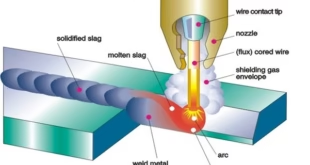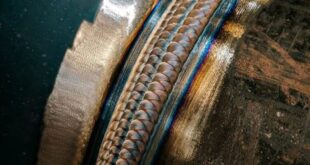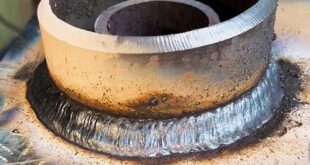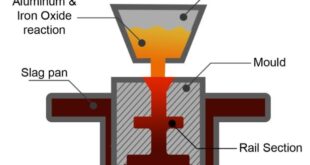Gas Metal Arc Welding
Introduction
Gas metal arc welding (GMAW), also known as metal inert gas (MIG) welding, is a welding process in which an electric arc is used to melt and join metal workpieces. A continuous wire electrode is fed through a welding gun, and an inert gas is used to shield the weld from contamination.
GMAW was developed in the 1940s and quickly became a popular choice for welding a variety of metals, including steel, aluminum, and stainless steel. The process is relatively easy to learn and can be used to weld thin or thick workpieces. It is also a fast process, making it suitable for high production environments. One of the main advantages of GMAW is that it produces a clean and visually appealing weld, which is why it is often used in the automotive and aerospace industries.
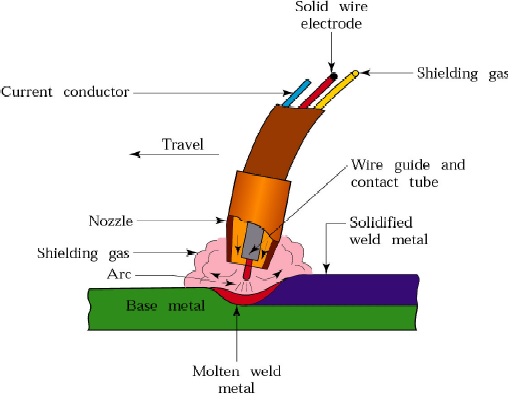
How GMAW Works
The GMAW process involves four main components: a power source, a welding gun, a continuously fed wire electrode, and an inert gas. The power source provides the electricity needed to create the arc. It can be a transformer-based machine or a more modern inverter-based machine. The welding gun holds the wire electrode and directs the arc to the workpiece. The wire electrode is a spool of wire that is fed through the welding gun and melted by the arc to create the weld. The inert gas, typically argon or a mixture of argon and carbon dioxide, is used to shield the weld from contamination by the atmosphere.
To begin the GMAW process, the workpiece is set up in the desired position and the power source is turned on. The welder then puts on personal protective equipment, including a helmet with a face shield to protect their eyes and face from the arc and spatter. The wire electrode is then loaded into the welding gun and the welder strikes an arc by touching the tip of the electrode to the workpiece and pulling it away. This creates a small, electric arc between the electrode and the workpiece, which melts the wire and the base metal. The welder moves the welding gun along the joint, adding more wire as needed, to create the weld. The inert gas flows from the welding gun and shields the weld from the atmosphere. GMAW is a versatile process that can be used to weld a variety of metals and alloys, including steel, aluminum, stainless steel, and copper. The process is fast and produces a clean, visually appealing weld, which is why it is widely used in the automotive, aerospace, and construction industries.
Advantages of GMAW
There are several advantages to using the GMAW process:
- High welding speed: GMAW is a fast welding process, which makes it suitable for high production environments. The continuous wire feeding allows for a high deposition rate, which means more weld can be deposited in a shorter amount of time.
- Good weld quality: GMAW produces a clean, visually appealing weld with minimal spatter. The inert gas shielding helps to prevent contamination of the weld, which can result in a stronger, more reliable weld.
- Wide range of materials that can be welded: GMAW can be used to weld a variety of metals and alloys, including steel, aluminum, stainless steel, and copper. This makes it a versatile process that can be used in a wide range of industries.
- Easy to learn: GMAW is a relatively easy process to learn, which makes it suitable for beginners and inexperienced welders.
- Portable: GMAW equipment is portable, which makes it suitable for on-site welding jobs.
- Versatility: GMAW can be used in various positions, including flat, horizontal, vertical, and overhead. This versatility makes it suitable for a wide range of welding applications.
Disadvantages of GMAW
There are also a few disadvantages to using the GMAW process:
- Limited penetration depth: GMAW is not as well suited for deep welds as some other welding processes, such as shielded metal arc welding (SMAW) or flux-cored arc welding (FCAW). This is because the arc is less stable at greater distances, which can result in a weaker, less reliable weld.
- Need for shielding gas: GMAW requires an inert gas to shield the weld from contamination, which can be an added cost. The gas also needs to be replaced regularly, which can be inconvenient.
- Potential for spatter and slag: GMAW can produce spatter, which is small drops of molten metal that fly off the weld during the welding process. This can be annoying to clean up and can also cause damage to nearby equipment. GMAW can also produce slag, which is a layer of solidified flux that covers the weld. The slag needs to be removed after the weld is complete, which can be time-consuming.
- Limited thickness: GMAW is not well suited for welding very thick materials, as the arc has difficulty penetrating through the metal. For thicker materials, other welding processes, such as shielded metal arc welding (SMAW) or flux-cored arc welding (FCAW), may be more suitable.
Applications of GMAW
GMAW is a widely used welding process with a variety of applications, including:
- Industrial manufacturing: GMAW is commonly used in the manufacturing of heavy equipment, such as tractors, bulldozers, and cranes. It is also used in the manufacture of pressure vessels, such as tanks and boilers, and in the production of structural steel.
- Automotive repair: GMAW is often used to repair and refurbish cars and trucks. It is a fast process that produces a clean, visually appealing weld, which makes it suitable for use in the automotive industry.
- Construction: GMAW is used in the construction of buildings, bridges, and other structures. It is a versatile process that can be used in various positions, including flat, horizontal, vertical, and overhead, which makes it suitable for a wide range of welding applications in the construction industry.
- Aerospace: GMAW is used in the manufacture and repair of aircraft, missiles, and space vehicles. The process produces a strong, reliable weld with minimal spatter, which makes it suitable for use in the aerospace industry.
- Shipbuilding: GMAW is used in the construction and repair of ships and other marine vessels. It is a fast process that produces a clean weld, which makes it suitable for use in the shipbuilding industry.
Safety Considerations for GMAW
GMAW is a safe welding process when proper precautions are taken. It is important for welders to use the proper protective equipment, including a welding helmet with a face shield to protect their eyes and face from the arc and spatter, gloves to protect their hands, and protective clothing to protect their skin and clothing from the heat and sparks.
There are several precautions that welders can take to avoid hazards while using the GMAW process:
- Use proper ventilation: GMAW produces fumes and gases that can be harmful if inhaled. Welders should ensure that there is adequate ventilation to dissipate these fumes and gases.
- Wear protective equipment: Welders should always wear the proper protective equipment, including a welding helmet, gloves, and protective clothing.
- Secure the workpiece: The workpiece should be securely clamped or held in place to prevent it from moving during the welding process.
- Follow safety guidelines: Welders should follow all safety guidelines and procedures, including those for handling and storing welding equipment and materials.
- Use proper techniques: Welders should be properly trained in the GMAW process and should use proper techniques to ensure the safety of themselves and others.
- Inspect equipment regularly: Welding equipment should be inspected regularly to ensure that it is in good working order. Any damaged or faulty equipment should be repaired or replaced immediately.
FAQs
Conclusion
In summary, gas metal arc welding (GMAW), also known as metal inert gas (MIG) welding, is a welding process in which an electric arc is used to melt and join metal workpieces. It is a fast process that produces a clean, visually appealing weld and can be used to weld a variety of metals and alloys, including steel, aluminum, and stainless steel. GMAW is widely used in the automotive, aerospace, construction, and shipbuilding industries. There are several advantages to using the GMAW process, including its high welding speed, good weld quality, and versatility in the materials it can be used to weld. However, there are also some disadvantages to consider, including its limited penetration depth, the need for an inert gas shield, and the potential for spatter and slag. GMAW is a safe welding process when proper precautions are taken, including the use of proper protective equipment and following safety guidelines. Welders should be properly trained in the GMAW process and should use proper techniques to ensure the safety of themselves and others.
In the future, it is likely that there will be continued developments in GMAW technology to improve the efficiency and effectiveness of the process. These may include the development of new power sources, welding guns, and wire electrodes, as well as the use of advanced computer algorithms to optimize the welding process.
 Welding of Welders All about Welding and Welders
Welding of Welders All about Welding and Welders
